What To Put In My Rice When Make Sushi
Authentic Japanese
Sushi Rice Recipe

This is the same sushi rice recipe that my now 80 twelvemonth old Japanese mother used to brand sushi for me when I was growing up.
And I promise you concord, there's nada like real accurate home cooked food. Whether that is proficient ole' southern cooking like turnip greens, pinto beans and cornbread... or authentic sushi rice...
The stuff that real Japanese people make in their homes everyday...
with that said...
Permit's become started!
Picking your Rice for this Sushi Rice Recipe
Y'all won't unremarkably find instructions for selecting and ownership your rice in almost whatever other sushi rice recipe found on the internet, but it cannot exist ignored.
This is a cadre requirement of this sushi rice recipe and critical for making the best sushi rice.

Get the Japanese Short Grain White Rice...
Start, y'all want the super premium Japanese curt grain white rice for this sushi rice recipe. 2 of the very best that you tin can get here in the U.Southward. (in my opinion) are Tamaki Gold and Tamanishiki. In that guild.
If you want to get a brown rice version of the 2 choices above, look at the amazon carousel below for "Tamaki Haiga" or "Tamanishiki Super Premium Brownish Rice". Both are of the aforementioned loftier quality except that superior polishing techniques allows for the bran to remain on the rice grain with these two technically making them slightly healthier choices.
And don't worry, they are both still pasty enough for your sushi and taste succulent. I personally employ Tamaki Haiga all the fourth dimension. Information technology has a slightly "nutty" flavor that is hard to beat...
Now for a little more on what gluey is and why information technology is important.
Japanese eat rice that is more glutinous than another asian countries. The more than glutinous a rice is, the meliorate it sticks together making it easier to pick upwards with chopsticks or grade into sushi rolls or rice assurance.
The short grain rice is the most glutenous. As you move from short to medium to long grain rice becomes less and less glutenous.
And I don't want to try to dissever hairs here, considering if you desire to brand the "all-time" sushi rice you should effort to use the brusque grain. Simply... with that said, yous CAN use medium grain if y'all can't find a brusque grain rice (Kokuho Rose and Nishiki both are a medium grain and would be an adequate choice if I could non find a premium short grain Japanese rice). Just try to purchase a premium quality that is "Start Crop" or "New Variety".
As a side note, that is why in some other asian countries (where they eat less mucilaginous rice) they can exist seen eating their rice with a spoon... because information technology doesn't hold together and tin can't be picked up well with chopsticks.

Look for "First Crop" or "New Diverseness" on the bag for this Sushi Rice Recipe...
Good standard brands that are widely available in the U.S. are Kokuho Rose and Nishiki. Considering of this, many people end up picking those up or getting them in sushi kits even though they are really just a 'B' grade diversity of rice for sushi.
Premium ones to look for again in the U.Southward. are, Tamaki Golden and Tamanishiki. In Nippon, the Koshikikari variety is the most popular and preferred rice cultivated in Nippon. And actually, Koshihikari harvested in Uonuma expanse of Niigata Prefecture is normally the most expensive rice in Japan.
Tamaki Gold is a California grown Koshikikari that is excellent . It is on par with the best Koshikikari cultivated in Nihon.
Tamanishiki is also a California grown rice that uses 2 kinds of super premium quality brusk grain rice; Koshikikari and Yuma Gokochi. The combination of the two creates both peachy flavor and a wonderful texture.
Whichever brand of rice you lot decide to selection, you want to try to get the rice that is labeled "First Crop" or "New Variety". This rice is picked in the fall and is the best rice for Sushi.
Also, try to discover a date on the purse that shows that the rice is no more than a twelvemonth old, if possible. The older the rice is, the harder it is and the more water information technology takes to soften; making it more difficult to make good sushi rice.
Ask your Japanese Grocer if the rice is "Shinmai"
If you happen to pick upwardly your rice in a skillful Japanese Grocery shop, inquire the owner for his or her suggestion for a adept sushi rice and also inquire if the rice is "Shinmai". Especially if your rice doesn't have "First Crop" or "New Variety" on the bag. Some first-class rice for sushi won't accept "First Crop" or "New Multifariousness" on the pocketbook but will only accept "premium brusk grain rice" on it. In this example, ask your grocer to exist sure.
To your grocer, "Shinmai" will mean electric current years crop and just might impress him (or her), peradventure earning you a few brownie points!
Buy the Rice you have to wash, Not the pre-washed rice for this Sushi Rice recipe
And ane more thing earlier we move on. At that place is a new blazon of rice out that has been "pre-washed". This rice does not require the normal rinsing to remove the "starch" that is present with the standard short grain white rice.
Our sushi rice recipe is NOT based on using the "pre-washed" rice. And then if your grocer has both, pickup the regular rice that has to be rinsed. The reason being is that the water amounts and even the cooking settings on the fancy rice cookers have to accept this into account because they practice melt differently.
Visit our Sushi Rice page to get a lot more background on sushi rice in full general.
Ok... back on track...
While you are picking up the Rice, too pickup...

- Japanese rice vinegar (or pre-fabricated Sushi Seasoning only if you lot tin't get regular rice vinegar). This is required. Any good quality rice vinegar will practise. Both Mizkan and Marukan are both popular and widely available in U.South. grocery stores. Become here to acquire more about rice vinegar in general.

- Kombu (dried seaweed). If you tin can find it (nigh Japanese grocery stores will have it, if non you tin go it here). If you desire to follow my mother'due south recipe to a tee you'll demand to obtain some. A round a 4" x vi" piece should do it for making one batch of sushi rice with this sushi rice recipe. To learn about kombu go here.
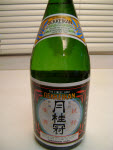
- Sake. You can discover this in any liquor store. And again, it is optional but it won't exist exactly similar mother's sushi rice recipe and won't exist as good without it...(it'south the trivial details that brand the divergence). Normally I go along Gekkeikan sake on hand for this.
Don't Skimp or Skip the Sake and Kombu... and Here's Why...
Earlier you decide to skip both "optional" items, Kombu and Sake in this sushi rice recipe, let me try to talk you out of information technology.
I asked my mother why she felt like they were both required and the first thing she said was, "You practise want to know how to make Sushi Rice don't you? Because information technology won't be good sushi rice without it".
Then I said again, "But WHY?"
She and then followed up with,
"The Kombu and Sake are both ingredients y'all employ in making skillful dashi so it gives your sushi rice nice hints of good dashi flavour".
Ahhh! And then THAT'S the existent reason...
For those that may not know, dashi is a mutual cooking stock used in a lot of japanese soups similar miso and clear goop. Like to how nosotros utilise craven stock in the U.South.
At present, I don't know if you simply noticed, but nosotros just witnessed good quondam fashioned Japanese home cooking in activeness folks...
the "surreptitious" role of her sushi rice recipe... :-)
No other sushi rice recipe that I take seen on the net (or anywhere actually...well...at to the lowest degree until at present...) apply both kombu and sake simply I will tell you that I think it does make the best sushi rice.
Try it for yourself, both with and without sake and kombu and allow me know what you remember!
Merely Shhhhh... remember... its our niggling secret...
Rice Cooker, Fancy Rice Cooker or merely a plain erstwhile Pot?
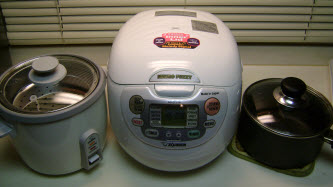
All in all, I don't think it really matters.
Personally, I have two Zojirushi's. A simple i push one (NHS-10 6 cup) on the left to a higher place, and a fancier i ( NS-ZCC18) in the middle to a higher place that uses the "fuzzy logic" engineering that does all of the thinkin' for you (I just love this unit.) It will pre-soak, cook, and steam the rice subsequently cooking for you; all you have to practice is wash the rice, put it in the pan, add h2o and push a button or 2.
If you desire to acquire everything you ever wanted to know about all the different models of Zojirushi rice cookers, visit my review page here.
But overall, rice cookers are squeamish to have to brand things more convenient and to give you more than options (like settings for regular rice, sushi rice, keep warm, etc.,). And they do make the rice cooking process more consistent.
In this sushi rice recipe however, we volition focus on using a plain old non-stick cooking pot with a lid. Everybody has one, and it will allow those who have not notwithstanding committed to investing in a rice cooker to experience the joy and pleasure of making sushi rice with this sushi rice recipe.
The procedure can exist slightly unlike betwixt using a pot as opposed to using a fancy dancy rice cooker but we'll focus on the pot method showtime and will cover the modest differences when using dissimilar rice cookers after.
How to Brand Sushi Rice using a Pot or Rice Cooker for this Sushi Rice Recipe
(This method is geared toward using a pot, with differences for using a rice cookers explained in the recipe. Points that cause confusion betwixt using a pot and rice cooker are explained beneath this recipe)
Ingredients
The post-obit products are ones I use ofttimes and are added for your shopping convenience:
Y'all will need the following ingredients on hand to cook sushi rice for this sushi rice recipe.
- 2 cups of Japanese curt grain white rice
- 2 Tablespoons Sake
- 2 cups of water (bottled water preferably) minus 2 tablespoons of water. Add together two tablespoons of Sake to replace the 2 tablespoons of h2o in your second cup of water.
- 4 x half-dozen inch piece of Kombu
And Homemade Sushi Seasoning:
(mix this now and so yous can occasionally stir it up while you are washing, cooking, and steaming the rice beneath. This will insure that all of the sugar is dissolved by the time you are ready to utilize it):
- 4 Tablespoons obviously Japanese Rice Vinegar (not the "seasoned" rice vinegar)
- 1 /ii teaspoon salt (upwards to 1 teaspoon on occasion... run across below)
- 5 tablespoons carbohydrate (down to ii tablespoons on occasion... see below)
When and why you may want to vary the Sugar and Common salt measurements to a higher place on occasion...
5 tablespoons is what my female parent commonly uses, recommends and swears by... a lot of other sushi rice recipes ever only apply 2 tablespoons.
Hither is why she commonly uses 5:
My female parent says she has had talks with many 1st class Japanese sushi chefs over the years (in Japan) and although they were hesitant to reveal the "underground" to their sushi rice recipe many did reveal hints; one of which she presently noticed became somewhat of a common thread --- that they preferred to make theirs a bit "sweeter".
With that said, permit'southward discuss when yous may desire to vary the sugar and table salt measurements above (which does lean toward the sweeter side).
In most cases, I make my sushi seasoning but every bit stated above. It is proficient in nearly types of sushi especially chirashizushi, futomaki, most makizushi (rolls) and those recipes using milder flavors and meats.
For Nigirizushi (oblong pad of rice with a topping across the peak) and stronger meats and flavors you lot may want to consider a little less sweet and a little more than salt.
Here is what I would suggest:
1. The beginning time you make this sushi seasoning follow the recipe above using:
- 4 Tbsp rice vinegar
- 1/2 tsp salt and
- v Tbsp sugar
2. The next fourth dimension, try (to me) the contrary terminate of the farthermost which is:
- 4 Tbsp rice vinegar
- 1 tsp table salt and
- two Tbsp carbohydrate. (not every bit sweet and a little saltier)
Determine which yous similar amend, or what you like better depending on what type of sushi you lot are making.
Or experiment and vary your preference between the two extremes higher up until y'all notice your sweet spot.
This is the real examination when you are making sushi rice at home... adapt the flavors co-ordinate to what yous are making or to what you like.
Ok. Dorsum on runway...
Let'due south recap...
There are really 3 "secrets" to my mother'southward sushi rice recipe:
1. Kombu
2. Sake
3. and Her homemade sushi seasoning
Leave whatsoever of the 3 above out, and your sushi rice won't be as skillful equally information technology could be.
Supplies
Hangiri
If you are going to use a hangiri to mix your sushi rice in (which is the best thing to use to mix and cool sushi rice), then make full it with water while preparing your sushi rice. This volition aid keep the rice from sticking to information technology. You can also add some rice vinegar to the water so information technology volition be close to the sushi seasoning in instance the rice absorbs a little of it. Visit our hangiri page to learn more.
Let's Start by Cooking the Rice for this Sushi Rice Recipe
Try to use a large heavy bottomed non-stick pot with a lid for cooking this rice.
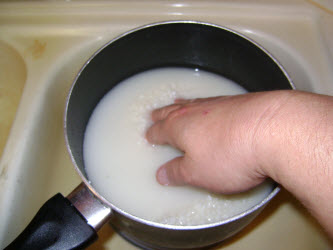
i. Launder the Rice. Put the ii cups of rice into the pot it is to exist cooked in and cover with articulate cool water. Swirl gently around with your paw in the pot to remove the "starch" that is on information technology.
The water will be somewhat "milky" looking in color. Drain the water using a sieve or by placing your hand or a lid on the top and turning the pot slowly sideways to bleed the water. Repeat this procedure four to 6 times equally necessary until the h2o is generally clear. Bleed this final rinse water thoroughly.
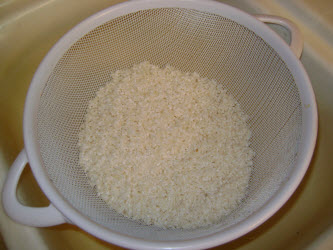
Here you can allow the rice sit down in a sieve and drain for 30 minutes or so before going to the side by side footstep. My mother swears past information technology. I promise that I tin can't tell a divergence.
The choice is yours, but at to the lowest degree you know...
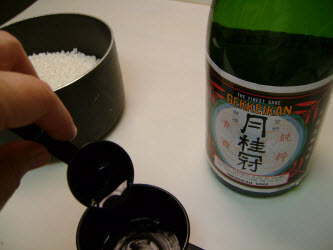
Add together 2 tablespoons of Sake to your ii cup measure commencement and so fill the remaining ii cups with water...
** Use bottled water to cook your rice with for the best taste, particularly if your tap h2o is soft, difficult, or tastes funky (similar if you accept sulfur well h2o). Your rice can exist ruined by bad tasting water.
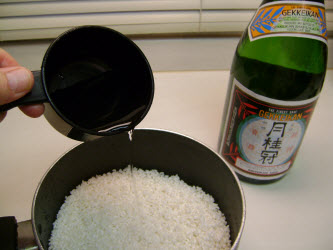
2. Add your h2o/sake mixture to your rice in your pot.
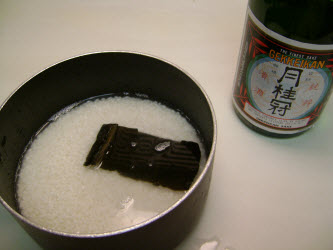
L ightly wipe off the Kombu if you take information technology and put information technology in the pot.
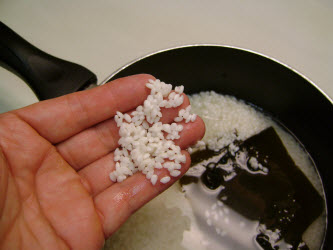
Do stride 3 if you are using a pot or elementary rice cooker. Skip it you accept a fancy rice cooker and it says that "soaking" is non necessary...
three. Fix the pot to the side to let the rice soak. What we desire is for the rice to turn "white". This is a very important step for pot cooked sushi rice so don't arrive a hurry or skip this step. This should take around 20 minutes give or take a few minutes. This results in a shinier rice with a meliorate texture.
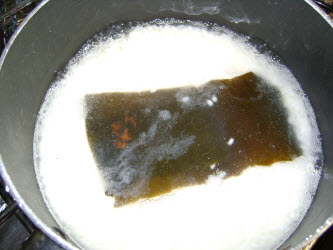
4. Plow the heat up to high, bring to a eddy.
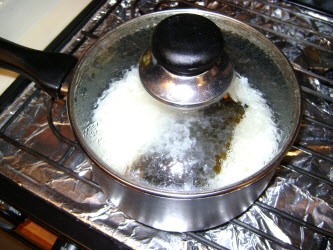
Reduce oestrus to low to reduce to a simmer. Put the chapeau on the pot. If using a rice cooker, simply plough it on co-ordinate to directions.
5. Cook for 15 minutes then plough off the heat. Your rice cooker will automatically turn off when it is done.
Do step vi if you are using a pot or simple rice cooker. Skip if y'all have a fancy rice cooker and it says that "steaming" is not necessary or that yous can open the rice cooker and fluff the rice as soon equally it stops cooking or turns off...(this is normally because the "steaming" is already factored into the time the unit stays on...)
6. Permit the rice "steam" for 20 minutes. DO NOT have the lid off of the pot during this time.
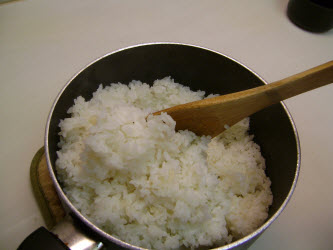
7. Accept the lid off and fluff the rice by turning it lightly over a few times using a wooden rice paddle. Replace the lid while you lot prepare your sushi seasoning. Either style, await five minutes after you fluff the rice in this pace before going to the next step.
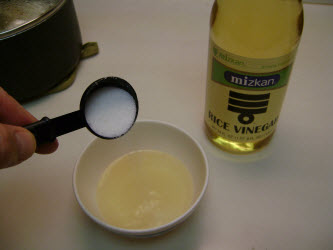
Make your Sushi Seasoning
8. Mix together the 4 Tbsp rice vinegar, 5 Tbsp sugar and 1/2 tsp salt in a small bowl. You can microwave it a little to help you go the sugar to dissolve if you need to (Mom doesn't agree then she doesn't microwave it though...she just keeps mixing till it dissolves...)
I unremarkably will start mixing the sushi seasoning while the rice is soaking, cooking, and so steaming and will periodically mix information technology to allow the sugar to deliquesce more slowly. By the time the rice is done, the carbohydrate will be dissolved and it will be well mixed.
Mixing the Sushi Seasoning with your Rice
ten. Next dump the hot rice into a very large bowl or preferably in a traditional wooden sushi tub chosen ahangiri. It is also referred to equally ansush ioki. If using a bowl as opposed to hangiri, put a clammy towel under it to go on information technology from sliding.
*** And as a side note, don't endeavour to scrape the harder rice upwards that may be stuck to the bottom of the pot. Leave information technology in the pot if it is stuck or hard or "crispy". These harder pieces volition not be good in your sushi rice ***
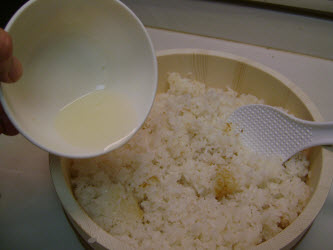
eleven. Spread the rice out and cascade the vinegar mixture all over the rice. The brown spot in the picture is non burnt rice, only rather where the kombu laid on the rice it left a brownish stain.
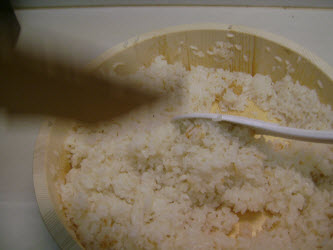
12. Now, if you have an electrical fan (this is what I use), betoken it down over the rice from your right or left side so that it blows over the rice. Try to mix the rice using a side to side cut motility with the border of your wooden spoon.
What you are trying to practise is coat each grain of rice and cool it apace at the same timewithout mashing the grains of rice. All of this helps to evaporate the liquid faster which gives the rice a dainty shine and also helps prevent mushiness.
xiii. If you don't have an electrical fan, then use a paw fan or a piece of cardboard (as in the picture-I did that to testify off-I normally use an electric fan :-) in one manus while using the mixing move described above with your other paw. Its a fleck trickier since you can't use i paw to concord the basin or hangiri in place, just yous'll quickly become the hang of information technology.
14. Yous can cease mixing when everything has been absorbed and is no longer moisture and slippery, the rice is fluffy and each grain is very shiny.
15. Cool to room temperature before using to brand your sushi. Y'all can cover the Hangiri with a clammy tea towel or damp cloth while information technology is cooling to keep the rice from drying out.
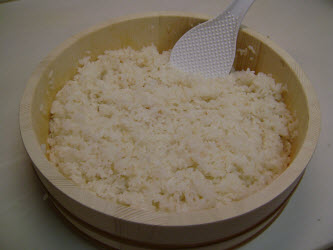
And there yous have information technology. This is how to brand sushi rice using the best sushi rice recipe bachelor out there.
Congratulations!
You lot now have Sushi rice that near sushi chefs would probably proudly serve in their restaurants and a sushi rice recipe that most would like to know!
Now... What do you make with your Rice? Hither's a few suggestions...
Now that you have your most bones essential ingredient you are ready to brand either your favorite nigiri sushi or maki sushi.
If yous don't know how to "roll", visit our "How to make Sushi Rolls" page to learn how.
If you lot need fish but don't know where to buy it or what to look for then that you lot know that it is safe to eat, visit our sushi course fish page to learn more.
If you are new to all of this in general, here'due south a few excellent suggestions for things to start out on.
Offset and foremost, you can't become incorrect with a California roll. Everybody loves crab and there is no raw fish to consume so it is a swell "beginner" recipe to try. The ingredients can too typically be obtained at your local grocery store. Check out our California scroll recipe if you lot want to give it a try!
Another one that I highly recommend for you to endeavor is this Seared Ahi Tuna Recipe... and although it does not call for rice, the seasonings that it is encrusted with along with the heavenly, creamy ginger soy sauce that you lot dip it in will absolutely make your rima oris water every time. Guaranteed!
Making Sushi Rice with a Rice Cooker
Let me start by saying that the basic rice cooking process is yet the aforementioned. There simply seems to be some confusion involved with this depending on how simple rice cooker or fancy your rice cooker is and whether or not you read the "how to use this rice cooker" directions before you follow this recipe.
Most of the confusion seems to come up upward if y'all actually read the directions that came with your rice cooker.
For one, the measurements stated in this recipe are in U.S. cups. The cups mentioned in the rice cooker instructions will be referencing the cup that is provided WITH the rice cooker which will be less than a U.S. loving cup.
The h2o fill markings inside the rice cooker container will relate to the measuring loving cup that was provided with the rice cooker.
In some cases, especially with the more expensive units, yous will take a marking for 'regular' rice and ane for 'sushi' rice. The sushi rice markers will exist lower than the regular rice ones because they are reducing the amount of h2o needed to create a firmer slightly drier rice, to compensate for the sushi seasoning vinegar that you will add afterward when you mix that liquid with the rice afterward cooking.
For this sushi rice recipe, ignore those h2o make full markings.
Just measure the rice and water in U.S. cups as stated in the recipe and plough it on and you will be fine.
And secondly, if you are using a fancy rice cooker with all the bells and whistles, you may Non take to practice the twenty minute soak to become the rice white before cooking (although information technology probably wouldn't hurt anything if you did anyway) and you lot may not have to wait 20 minutes to "steam" the rice after the unit cuts off equally the steaming may already be compensated for during cooking time...
Just read the instructions with your rice cooker to make certain.
That volition keep everything uncomplicated for you if you are new to making sushi with a sushi rice recipe or using rice cookers.
After you become familiar with both and have had bully success, then experiment with all of the settings that your rice cooker may accept.
Similar this Page?
Source: https://www.allaboutsushiguide.com/sushi-rice-recipe.html
Posted by: jacksonshoul1978.blogspot.com


0 Response to "What To Put In My Rice When Make Sushi"
Post a Comment